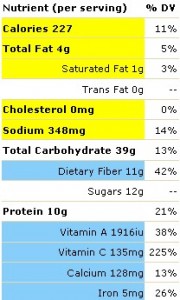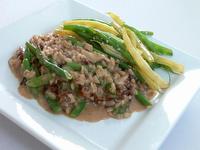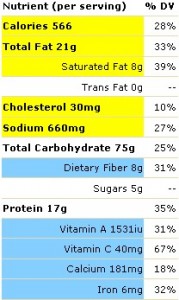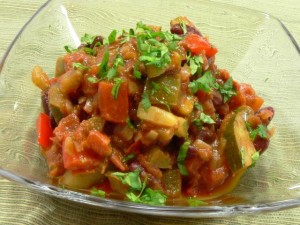Archive for the ‘Articles’ Category
It’s always a question of time
February 17 2011
“We never seem to have enough time.” 
At least that’s what most people say. I always think that it’s one of the few things I have lots of. (HA!)
But when I am pressed for time, I look for things that will make my life easier. For example, tonight, my wife has an engagement she must attend and therefore won’t be home for dinner. So it’s up to me to collect our little one from daycare and then make us dinner before someone has a “meltdown” (That would be my daughter, not me). In anticipation of needing to make dinner as fast as possible, I planned on spaghetti for tonight. The sauce is defrosted, the water is in a pot and on the stove, the colander is in the sink and the pasta is measured out.
This may seems like small potatoes but now when I get home and NEED to have dinner ready in 10 minutes, I can do it. It took me a whole 5 minutes this morning to organize things for dinner and now all I have to do is turn on the stove and wait for the pasta to cook as I am reheating the sauce. Toddler tantrum avoided!
This just shows the importance of planning.
On Monday evening we had pork chops with white beans. I like to use dried beans rather than canned so I must plan ahead if I want the family to eat at a decent hour. Hence, I soaked the beans on Sunday night and then on Monday morning before heading to work, while showering, getting our daughter ready etc, I had time to cook the beans. I drained them, let them cool and then placed them in the refrigerator.
Once I got home on Monday evening, all I had to do was turn the oven on, sauté the pork chops and then reheat the beans. As the pork chops cooked, I had plenty of time to add whatever vegetables I wanted to the beans as they reheated. I had some leftover roasted carrots and beets from Sunday’s meal which I chopped up and added to the beans as well as some wonderful fresh spinach one of the local farmers gave me…dinner in 20 minutes!
How? Because I planned ahead.
Chef Paul: February Food
February 11 2011
It’s tough this time of year.
Winter seems to be dragging on, you don’t get enough outdoor exercise and, if like me you live in a cold climate, there  just isn’t much choice at the Farmer’s Market. As I mentioned before, we like to get most of our groceries from the local farmer’s market. But right now it’s root vegetables, root vegetables and more root vegetables. Now, I love me a good sweet potato stew and a roasted beet salad but still my body needs some green vegetables. There are some “end of season” Brussels sprouts available as well as some curly kale, but I long for the early days of spring when asparagus arrives.
just isn’t much choice at the Farmer’s Market. As I mentioned before, we like to get most of our groceries from the local farmer’s market. But right now it’s root vegetables, root vegetables and more root vegetables. Now, I love me a good sweet potato stew and a roasted beet salad but still my body needs some green vegetables. There are some “end of season” Brussels sprouts available as well as some curly kale, but I long for the early days of spring when asparagus arrives.
So, this time of year we end up getting more from the grocery store than we normally do. Be it lettuce, broccoli or citrus fruit, sometimes we’ve just got to succumb and buy non-local. I stress here that these are my family’s choices. I am not condemning anyone who buys exclusively from the grocery store by any means…it’s just that we feel it’s very important to know where our food comes from. And yes, we have visited most of the farms we buy from…there’s even an organic Upick farm a couple hours away, my daughter loves it there.
Regardless of where you buy your vegetables and fruit, proper storage and care of the product is a must. Over on our facebook page, we were asked recently for tips regarding vegetable storage. Now, while not all vegetables are the same and you’ll never get two chefs to agree on anything let alone how to store vegetables, here are my two cents.
Storage Tips:
For the aforementioned root vegetables, I find it best to store potatoes and other tubers below room temperature, say between 4C and 8C in a dark well ventilated area (optimally a cold storage area if you can). Otherwise, you can store potatoes in a paper bag at room temperature for about a week or two as long as it’s dark and well ventilated (a cupboard works fine). We almost never keep potatoes in the refrigerator because this will release their starch and make them taste…well, starchy. I say almost never because new potatoes can be stored in the refrigerator as can Yukon gold or other yellow flesh, less starchy potatoes, for up to two weeks or so.
Carrots and their like, I store in the refrigerator in a well ventilated compartment or container. As for leafy greens, I ALWAYS wash and spin them dry as soon as I return from the market. I then place them in resealable containers with a towel (or paper towel) above and below the product to absorb any moisture. The two keys to this are buying fresh and spinning as dry as you can. We’ll talk about other vegetables as they come into season.
The best tip I can pass along is “buy local” whenever possible. It’s amazing how much longer the head of lettuce I buy at the farmer’s market lasts when compared to the “box ‘o’ greens” you get from the supermarket that has gone brown and wilted by the time you get home. Same goes for any vegetable; the closer you are to the farm the less it has travelled, the fresher the ingredient …longer it will last. Believe it or not, those lettuce greens from South America don’t fly here first class. They get picked well before their peek ripeness and “ripen” on their slow boat from Caracas. You may scoff at the price of buying local organic veggies but when you consider how much rotting lettuce you end up tossing out that extra $0.50 doesn’t seem like too much.
I’ll address other tip topics in future blog posts so stay…posted (couldn’t resist that one).
Chef Paul: Food Inc.
February 08 2011
If you haven’t seen Food Inc. I strongly recommend that you do.
The film explores the relationship between the food we eat and how we grow and buy that food.
As someone who reads this blog you are obviously concerned about what goes into your food and into your body. It’s obvious from watching this film that our governments are not interested in helping us out when it comes to nutrition. They’re much more interested in money and keeping the big food companies happy than in the average consumer. How else can we explain the lack of oversight and continuous changing of the rules to help these large food conglomerates reap profits?
The shocking and deplorable state of large scale farming is exposed for what it is; a money making machine with little regard for the health or wellbeing of either their products or their customers.
It all seems a bit overwhelming. How can we as individuals even begin to change things when even our governments seem powerless in the face of these Goliaths? The answer is simple. We must start to cook more at home and end our reliance on convenience foods and fast foods. If you really truly saw what goes into a lot of the “products” in the grocery store and fast food joints out there you’d be appalled. Many of these “foods” are “created” with the goal of filling you up and then leaving you hungry again in no time when, hopefully, you’ll go back and have another of their “products”.
People need to become more aware of the food they eat, where it comes from and how it is prepared or farmed. It’s up to us to make the effort and make choices that are both healthy for us and for future generations. We can’t wait for the government and food lobbies to make changes…it has to begin at home.
Super Bowl Supper
February 04 2011
I am not a football fan…never have been, never will be. So unlike most, this Sunday will just be a regular ole Sunday around our place. Don’t get me wrong, I love sports…but not football. So we’ll probably do something outside, assuming the weather cooperates. My daughter has wanted to go on a sleigh ride for a while now therefore we may end up going to a farm about an hour from our place.
Then in the afternoon, I’ll cook up a stew or chili or something else that will leave lots of leftovers that we can have for lunches or quick suppers.
So, if you’re like me and couldn’t care less about “the big game” and everyone else in your household is transfixed by the TV, this is your perfect opportunity to cook. Sure, you may need to make a snack for the boys at some point but you should have hours for yourself in the kitchen…this is a dream come true for me.
Here’s a not so standard chili recipe from our site for you to try. I’ve scaled for 16 portions so that you can make a big batch to use for lunches or quick suppers.
It’s vegetarian…but tell them there’s beer in it and they won’t even notice the lack of meat.
Servings: x16
Preparation Time: 15 minutes
Cooking Time: 25 minutes
Cuisine Type: North American
Freezable: Yes
Ingredients:
- 2 2/3 tbsp olive oil
- 4 cups onion, yellow, diced (~5 3/4)
- 16 cloves garlic, minced (~1/3 cup)
- 2 celery stalk, chopped (~2/3 cup)
- 4 chilies, green, finely chopped (~1/3 cup)
- 4 peppers, green, chopped (~3 1/4 cups)
- 4 pepper, red, chopped (~3 1/4 cups)
- 2 2/3 tbsp chili powder
- 1/4 cup cocoa powder
- 2 cinnamon, sticks

- 16 cups tomatoes, canned diced, no salt added, with juice
- 6 cups beans, red kidney canned without salt, drained, rinsed
- 4 zucchini, green, quartered, chopped (~6 1/3 cups)
- 4 cups beer, ale
- 2 tsp salt, sea
- 1 tsp pepper, black freshly ground
- 1/2 cup cilantro, fresh, chopped
Instructions:
Cooking
1. Heat the oil in a pot over medium high heat.
2. Add the onions, garlic, celery, green chili, green pepper and red pepper, and saute, stirring, until soft, about 5 minutes.
3. Stir in the chili powder, cocoa and cinnamon.
4. Add the tomatoes and their juice, beans, zucchini and beer.
5. Bring to a boil, reduce the heat to low and simmer for 20 minutes.
6. Remove the cinnamon stick, season and serve topped with cilantro.
Can you Save with Meal Planning?
January 31 2011
 On Wednesday of this week I will be doing an interview with an Ottawa radio station. The theme of the interview is about cost savings with a meal plan. Basically, they want to know if a person can really save money by planning their meals.
On Wednesday of this week I will be doing an interview with an Ottawa radio station. The theme of the interview is about cost savings with a meal plan. Basically, they want to know if a person can really save money by planning their meals.
It seems an obvious enough answer to me…anytime you plan you end up saving money. Whether it’s planning a vacation or planning a family outing; the more thought you put into it, usually, the more you save.
When it comes to meal planning, the cost savings can be astronomical! Most people don’t realize how much money they spend on lunches. Hey, it’s only $6 for the burger combo at the local fast food joint but you probably could have made your lunch for less that $2…that’s a difference of 300%!! Imagine if you bought your lunch every work day. Let’s say an average of $7 per day…that’s $35 per week…which is $1700 a year! That’s a big chunk of change.
As for dinners, lasagna at your typical big box eatery will run you about $12.95. With that you get Caesar salad and “unlimited garlic bread”. You could easily make a lasagna at home for under $2 a portion…that’s a whopping 600%!!!
Sure, not everyone eats out all the time and the occasional restaurant meal won’t break the bank, but planning your weekly meal schedule will also help decrease your grocery bills. Using the MealEasy grocery list that automatically compiles all the groceries you’ll need to make the scheduled meals, you will easily cut down on “impulse buys” and food that ends up going bad.
And we’re only talking cost savings here. We’re not even talking about your health and well being. Eating homemade food simply makes sense and saves!
Chef Paul: It’s Cold Outside!
January 26 2011
We’re experiencing a cold snap here in Halifax right now…it’s brutally cold.
When the thermometer goes this low I like to cook hearty, stick-to-your-bones kind of meals like stews and risottos. Tonight for diner I’ve planned a mushroom risotto to go along with some pork tenderloin. Many people are intimidated by risotto and therefore never make it. While they are time consuming, risottos are not all that difficult to make.
I always start by sweating off some finely chopped onions and then adding the rice and toasting it until the grains begin to change colour. Then, I add wine, either red or white depending on what else I’m putting in the risotto. Once the wine has been absorbed by the rice, I begin to slowly add the stock one ladle at a time (either chicken or beef, again depending on the other ingredients).
Now you stir…and stir…and stir continuously adding stock until it is absorbed by the rice.
A good risotto takes time, usually about 25 to 30 minutes. There are no shortcuts. The liquid has to be slowly absorbed by the rice in order to get that wonderful creamy consistency.
Once your rice is almost cooked you can begin adding your other ingredients like mushrooms, parmesan, squash, asparagus, etc. If you add your ingredients too soon, you’ll slow down the cooking process.
For most people, the hard part is knowing when the rice is done or almost done. The only way to tell is by tasting it. The rice should be soft but not mushy; it should retain it’s firmness without being crunchy. I’ve added quite a few risotto recipes to the MealEasy site, all with simple to follow instructions that I know will easy your trepidation towards risotto…give it a try. Once you’ve made one of these risotto recipes, you’ll no longer be intimidated.
Risotto with Asparagus and Shiitake Mushrooms 



Servings: x4
Preparation Time: 10 minutes
Cooking Time: 25 minutes
Cuisine Type: Italian, North American
To freeze extra portions for future use, increase the number of servings by clicking on “Edit Meal” in “Meal Options”.
Ingredients:
- 3 cups chicken broth, canned, low sodium
- 3 cups water
- 1 lb asparagus, trimmed, peeled and cut into 1/2″ long pieces (~3 1/3 cups)

- 1 onion, yellow, finely chopped (~2/3 cup)
- 2 tbsp butter, unsalted
- 1 1/2 cups rice, arborio
- 1/2 cup wine, white dry
- 8 oz mushroom, shiitake, stemmed and sliced thin (~12 2/3)
- 1 cup tomatoes, sun-dried, in oil, drained, chopped
- 1/3 cup walnuts, toasted
- 2 tbsp cream, heavy (35%)
- 1/4 cup cheese, Parmesan, low sodium, finely grated
- 1 tbsp lemon juice
- 1/4 tsp salt, kosher
- 1 tsp pepper, black freshly ground
Instructions:
1. Cooking
1. Bring broth and water to a boil in a pot.
2. Add asparagus and cook for 3 minutes, until just soft.
3. Transfer asparagus with a slotted spoon to a large bowl of ice and cold water to stop cooking, then drain and pat dry.
4. Keep broth at a simmer.
5. Cook onion in 1/4 cup butter in saucepan over medium low heat, stirring, until softened, about 3 minutes.
6. Add rice and cook, stirring, 1 minute.
7. Add wine, increase heat to medium high and cook, stirring, until absorbed, about 1 minute.
8. Ladle in 1 cup simmering broth and cook, stirring, until absorbed, about 2 minutes.
9. Continue simmering and adding broth, about 4 oz at a time, stirring frequently and letting each addition be absorbed before adding next, until rice is just tender and looks creamy, about 18 minutes.
10. Add the slice mushrooms, chopped sun-dried tomatoes, walnuts, heavy cream and asparagus to the rice.
11. Simmer for 2 minutes.
12. Remove from heat and stir in the cheese, lemon juice, salt and pepper.
Vegetarian cooking
January 24 2011
While no one at my house is a vegetarian, we do make it a point of eating a vegetarian meal at least once a week. Initially some members of the household ( my wife) were not too keen on the idea of a meatless dinner but now everyone enjoys it.
my wife) were not too keen on the idea of a meatless dinner but now everyone enjoys it.
Like many raised on a diet of meat and potatoes, my wife’s reticence for trying anything tofu goes way back. Not that vegetarian means there has to be tofu, or that tofu has to taste like mush, but like most non vegetarians, that was what she thought being meatless was all about.
Now that we have vegetarian meals on a regular basis and she has seen the variety of options out there, she has fully embraced our meatless dinners.
Eating vegetarian meals is tricky at first. You’ve got to make sure you’re getting the proper nutrients and protein. There’s more to it than replacing your meat with tofu. On the MealEasy site, we’ve made sure that there is a great variety of healthy and nutritious vegetarian meals using all kinds of beans, lentils, fruits, vegetables and yes tofu.
I’ve introduced my wife to a whole range of vegetables that she would avoid before, either because she’d never had them or in most cases because she’d never had them cooked properly (mushy grey beans anyone?).
Chef Paul: Chicken Soup for the Cold
January 20 2011
By now you’ve probably heard about my big bird…
the chicken I roasted a couple weekends ago.
Well, what I forgot to mention is that I also made some chicken stock using the bones of said chicken. I got about 4 liters of stock which I then froze for later use. I’m sure it sounds like we’ve got the world’s biggest chest freezer but I assure you that it’s a regular ole freezer. What is special about it is that when something goes in, we always try to take something out. Things can easily get lost at the bottom of a chest freezer.
But enough about my appliances (for now), let’s talk chicken (it’s not as formal as talking turkey). Continue reading
Canadian Running Recipe
January 18 2011
We’ve been asked to contribute a recipe for the May issue of Canadian Running. The way it works is their nutritionist talks about certain healthy foods in each issue and then I choose from those ingredients and send a  recipe that uses at least one of the ingredients.
recipe that uses at least one of the ingredients.
Instead of using a healthy recipe from our site, I’ve decide this would be a great opportunity to create a new recipe from scratch. Some of the ingredients to be featured are blueberries, quinoa, brown rice, dried dates, canned salmon, flax oil, and sundried tomatoes all of which are used frequently in our current recipes.
I am hoping to come up with something that not only uses at least three of these ingredients but is also low fat, low sodium and high in protein, vitamins and minerals…much like the recipes at MealEasy.com. Looking at the list it should be pretty easy. Quinoa, blueberries and sundried tomatoes are some of my favourite things to cook with. I love the nuttiness and texture of quinoa; the wonderful flavour of blueberries (and their incredible nutritional punch); as well as the salty chewiness of sundried tomatoes.
We’ll be filming the cooking and testing process so we can add it to our library of videos for the site. Look for it in a later blog and also, look for the May issue of Canadian Running for the recipe. Hey, if they like it, hopefully they’ll ask me to write a recipe for Canadian Cycling, their sister publication, as well.
Chef Paul: It’s Friday!
January 14 2011
And that means two things…the weekend starts tomorrow and most importantly, it’s pizza night!
I make a batch of pizza dough which I then separate into four and freeze for later use. I’m alw ays planning ahead when it comes to meals. This way, on Friday’s I can come home, turn on the oven, chop some veggies and off we go. We love pizza night around our house. My daughter helps me make the pizza and we all sit on the floor in the living room and listen to music and drink wine…well it’s beer (apple juice) for the little one. Tonight’s pizza will feature chicken left over from last weekend’s roast chicken too. YUM!
ays planning ahead when it comes to meals. This way, on Friday’s I can come home, turn on the oven, chop some veggies and off we go. We love pizza night around our house. My daughter helps me make the pizza and we all sit on the floor in the living room and listen to music and drink wine…well it’s beer (apple juice) for the little one. Tonight’s pizza will feature chicken left over from last weekend’s roast chicken too. YUM!
My daughter loves helping dad make pizza. She helps place the ingredients on the dough…that’s if she hasn’t eaten all of them. She adores olives and goat cheese…not your typical fare for a 2 1/2 year old.
The weekend also means a trip to the farmer’s market. We buy about 90% of our groceries from the farmer’s market. I feel it’s very important to buy local and to buy organic whenever possible. Many of the farmers I buy from are farm’s we’ve visited, so I know that the cows were pasture raised on a diet of grass; I know that the carrots and beets I’m getting were not sprayed with pesticides; and I know that the dollars I spend are going to the people who deserve it and need it most…the farmers.
I try to always take my daughter along when we go to visit farms so that she understands where her food comes from. She knows that the pig she’s looking at will be slaughtered and eaten, same goes for the chickens, cows etc. (She calls beef “cow beef” which I adore). I feel it’s very important for her to understand that her food does not come from a grocery store but from a farm…because without farms and farmers, where would we be?



